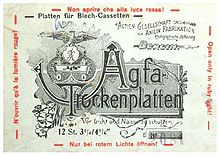Photographic plate


Photographic plates preceded photographic film as a means of photography. A light-sensitive emulsion of silver salts was applied to a glass plate. This form of photographic material largely faded from the consumer market in the early years of the 20th century, as more convenient and less fragile films were introduced. However, photographic plates were in wide use by the professional astronomical community as late as the 1990s. Such plates respond to ~2% of light received.
Glass plates were far superior to film for research-quality imaging because they were extremely stable and less likely to bend or distort, especially in large-format frames for wide-field imaging.
Scientific uses
Astronomy
Many famous astronomical surveys were taken using photographic plates, including the first Palomar Observatory Sky Survey (POSS) of the 1950s, the follow-up POSS-II survey of the 1990s, and the UK Schmidt survey of southern declinations. A number of observatories, including Harvard University and Sonneberg Observatory, maintain large archives of photographic plates, which are used primarily for historical research on variable stars.
Many solar system objects were discovered by using photographic plates, superseding earlier visual methods. Discovery of minor planets using photographic plates was pioneered by Max Wolf beginning with his discovery of 323 Brucia in 1891. The first natural satellite discovered using photographic plates was Phoebe in 1898. Pluto was discovered using photographic plates in a blink comparator; its moon Charon was discovered by carefully examining a bulge in Pluto's image on a plate.
Physics
Photographic plates were also an important tool in early high-energy physics, as they get blackened by ionizing radiation. For example, Victor Franz Hess discovered, in the 1910s, cosmic radiation as it left traces on stacks of photographic plates, which he left for that purpose on high mountains or let into the even higher atmosphere using balloons.
Medical imaging
The sensitivity of certain types of photographic plates to ionizing radiation (usually X-rays) is also a useful in medical imaging and material science applications, although they have been largely replaced with reusable and computer readable image plate detectors and other types of X-ray detectors.
Decline
Use of photographic plates has declined significantly since the early 1980s, replaced by charge-coupled devices (CCD). CCD cameras have several benefits over glass plates, including high efficiency, linear response to light, and simplicity of image acquisition and processing. However, even the largest format CCDs (e.g., 8192x8192 pixels) still do not have the detecting area and resolution of most photographic plates, which has forced modern survey cameras to use large arrays of CCD chips.
Several institutions are setting up archives to preserve the original plates, preventing valuable historical astronomical data from being lost.
See also
References
- Peter Kroll, Constanze La Dous, Hans-Jürgen Bräuer: "Treasure Hunting in Astronomical Plate Archives." (Proceedings of the international Workshop held at Sonneberg Observatory, March 4 to 6, 1999.) Verlag Herri Deutsch, Frankfurt am Main (1999), ISBN 3-8171-1599-7
